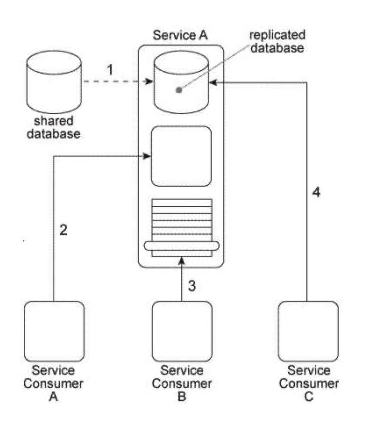Service A is a utility service that provides generic data access logic to a database that contains data that is periodically replicated from a shared database (1) . Because the Standardized Service Contract principle was applied to the design of Service A, its service contract has been fully standardized. Service A is being accessed by three service consumers. Service Consumer A accesses a component that is part of the Service A implementation by invoking it directly (2) . Service Consumer B invokes Service A by accessing its service contract (3) . Service Consumer C directly accesses the replicated database that is part of the Service A implementation (4) .  You've been told that the reason Service Consumers A and C bypass the published Service A service contract is because, for security reasons, they are not allowed to access a subset of the operations in the WSDL definition that expresses the service contract. How can the Service A architecture be changed to enforce these security restrictions while avoiding negative forms of coupling?
You've been told that the reason Service Consumers A and C bypass the published Service A service contract is because, for security reasons, they are not allowed to access a subset of the operations in the WSDL definition that expresses the service contract. How can the Service A architecture be changed to enforce these security restrictions while avoiding negative forms of coupling?
A) The Contract Centralization pattern can be applied to force all service consumers to access the Service A architecture via its published service contract. This will prevent negative forms of coupling that could lead to problems when the database is replaced. The Service Abstraction principle can then be applied to hide underlying service architecture details so that future service consumers cannot be designed to access any part of the underlying service implementation.
B) The Contract Centralization pattern can be applied to force service consumers to access the Service A architecture via its published service contract only. The Service Loose Coupling principle can then be applied to ensure that the centralized service contract does not contain any content that is dependent on or derived from the underlying service implementation.
C) The Concurrent Contracts pattern can be applied to Service A in order to establish one or more alternative service contracts. This allows service consumers with different levels of security clearance to continue accessing the service logic via its published service contracts.
D) None of the above.
Correct Answer:
Verified
Q9: It has been confirmed that Policy A
Q10: You are told that in this service
Q11: Service A is a utility service that
Q12: Service A is a task service that
Q13: When Service A receives a message from
Q15: Service A is a task service that
Q16: Service A is an entity service that
Q17: Services A, B, and C are non-agnostic
Q18: Service A is a task service that
Q19: Service Consumer A sends a message to
Unlock this Answer For Free Now!
View this answer and more for free by performing one of the following actions

Scan the QR code to install the App and get 2 free unlocks

Unlock quizzes for free by uploading documents